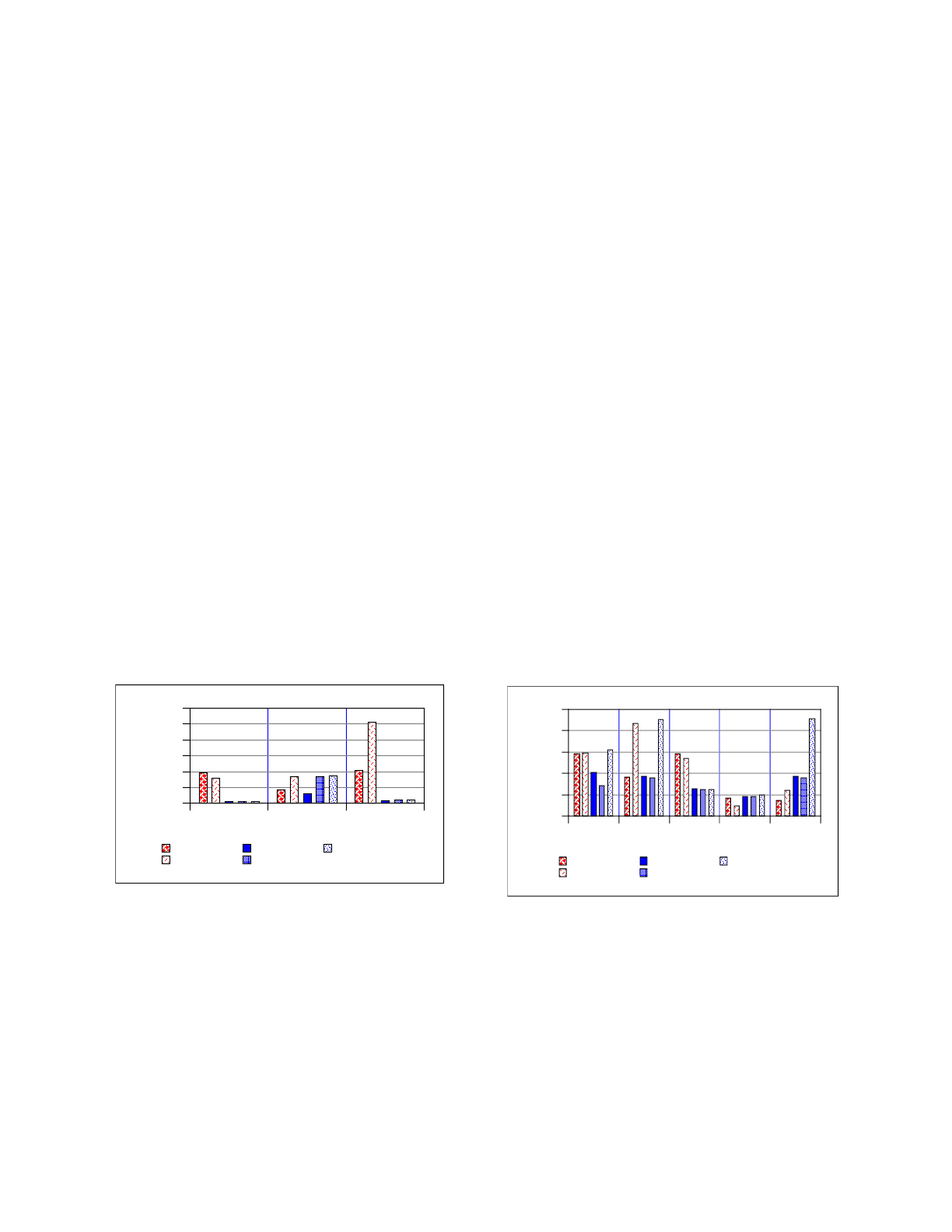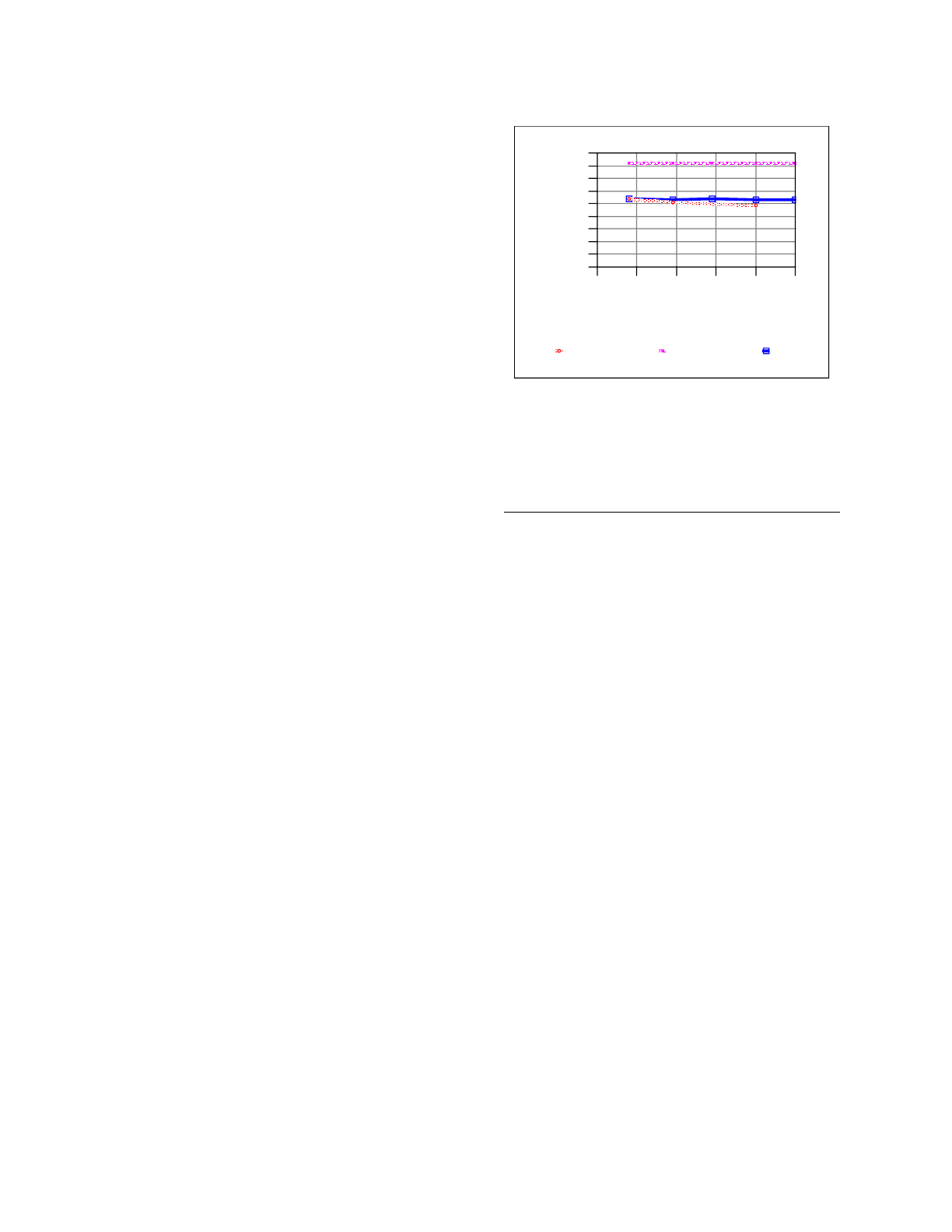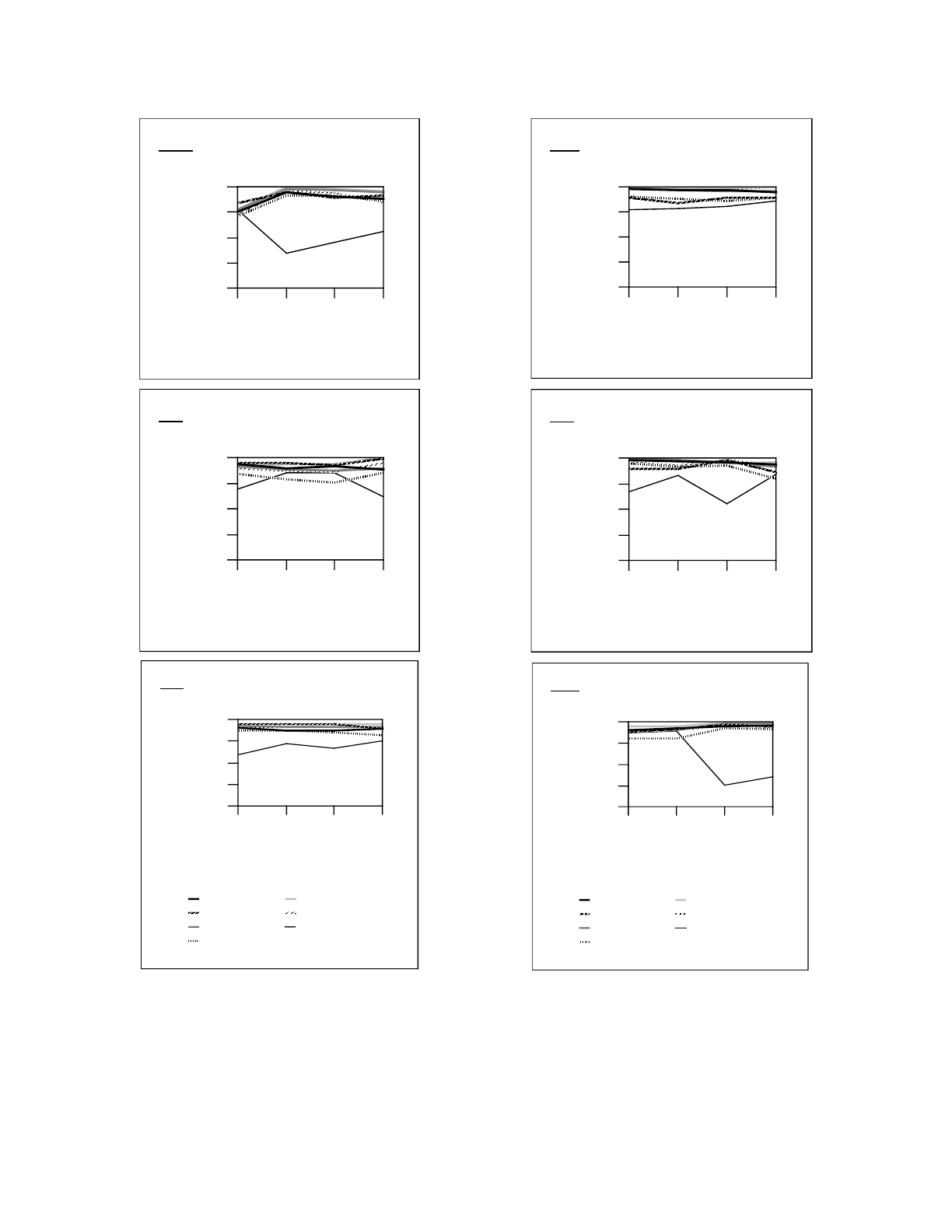
File System Logging Versus Clustering: A Performance Comparison
Margo Seltzer, Keith A. Smith
Harvard University
Hari Balakrishnan, Jacqueline Chang, Sara McMains, Venkata Padmanabhan
University of California, Berkeley
Abstract
The Log-structured File System (LFS), introduced in
1991 [8], has received much attention for its potential
order-of-magnitude improvement in file system
performance. Early research results [9] showed that
small file performance could scale with processor
speed and that cleaning costs could be kept low,
allowing LFS to write at an effective bandwidth of 62
to 83% of the maximum. Later work showed that the
presence of synchronous disk operations could
degrade performance by as much as 62% and that
cleaning overhead could become prohibitive in
transaction processing workloads, reducing
performance by as much as 40% [10]. The same work
showed that the addition of clustered reads and writes
in the Berkeley Fast File System [6] (FFS) made it
competitive with LFS in large-file handling and
software development environments as approximated
by the Andrew benchmark [4].
These seemingly inconsistent results have caused
confusion in the file system research community. This
paper presents a detailed performance comparison of
the 4.4BSD Log-structured File System and the
4.4BSD Fast File System. Ignoring cleaner overhead,
our results show that the order-of-magnitude
improvement in performance claimed for LFS applies
only to meta-data intensive activities, specifically the
creation of files one-kilobyte or less and deletion of
files 64 kilobytes or less.
For small files, both systems provide comparable read
performance, but LFS offers superior performance on
writes. For large files (one megabyte and larger), the
performance of the two file systems is comparable.
When FFS is tuned for writing, its large-file write
performance is approximately 15% better than LFS,
but its read performance is 25% worse. When FFS is
optimized for reading, its large-file read and write
performance is comparable to LFS.
Both LFS and FFS can suffer performance
degradation, due to cleaning and disk fragmentation
respectively. We find that active FFS file systems
function at approximately 85-95% of their maximum
performance after two to three years. We examine
LFS cleaner performance in a transaction processing
environment and find that cleaner overhead reduces
LFS performance by more than 33% when the disk is
50% full.
1 Introduction
The challenge in building high performance file sys-
tems is in using the disk system efficiently. Since
large caches reduce read traffic but do little to reduce
write traffic, the critical issue is write performance.
Achieving efficient writes to disk implies writing data
in large, contiguous units. The central idea in log-
structured file systems is that, by aggressively caching
data and applying database logging techniques, all
disk writes can be made sequential.
The early work in log-structured file systems
focused on how to build such file systems. The key
issues were providing efficient reads in a file system
that was written sequentially and maintaining large
contiguous regions on disk. The seminal work on log-
structured file systems [9] showed how conventional
file system structures could be implemented in an LFS
and how the combination of a segmented log and a
cleaner process (garbage collector) could be used to
maintain large, contiguous regions of disk space. The
work’s main focus was on the design of log-structured
file systems and on the derivation of efficient
algorithms for segment cleaning. The performance
results reported long-term cleaning summaries (e.g.
number of segments cleaned and average utilization

of cleaned segments) and micro-benchmarks that
demonstrated the strengths of LFS.
The paper by Seltzer et al. [10] discussed design
modifications necessary to incorporate LFS into a
BSD framework. The performance analysis presented
there focused on areas not covered by Rosenblum and
Ousterhout, with an emphasis on workloads that
stressed the cleaning capabilities of LFS. It concluded
that the clustering modifications to FFS made it
competitive with LFS in reading and writing large
files and in software development environments (as
characterized by the Andrew benchmark), cleaning
overhead in LFS degraded transaction processing
performance by as much as 40%, and the general
applicability of LFS and its competitiveness with FFS
warranted further investigation. This paper is part of
that further investigation, analyzing the performance
of LFS and FFS, and focusing on the areas that pose
the greatest challenges to each system. We focus on
four main issues:
• validating the BSD-LFS implementation by
comparing its performance to that of Sprite-LFS,
• the interaction of file size and performance for
sequential access,
• the impact of disk fullness on cleaning overhead
in a transaction processing workload, and
• the impact of free space fragmentation on FFS
performance.
In Section 2 we compare the BSD
implementation of LFS to the Sprite implementation
of LFS to validate that we are measuring a
representative implementation of a log-structured file
system. In Section 3 we examine performance as a
function of file size. In Section 4 we examine the
performance of the two file systems in a transaction
processing environment, with special attention given
to LFS cleaning and its performance as a function of
disk fullness. In Section 5 we discuss the effect of
disk fragmentation on FFS performance. Section 6
summarizes this study.
1.1 Overview of FFS
The BSD Fast File System can be described in terms
of its bitmap, which keeps track of the free space, and
its cylinder groups, which correspond to collections
of cylinders and provide for regions of allocation and
clustering. Information is arranged on disk in terms of
three units: blocks, partial blocks called fragments,
and contiguous ranges of blocks called clusters. In
principle, placing related files and their inodes in the
same cylinder group provides for a high degree of
locality, and allocating blocks contiguously in clusters
provides the opportunity for large, sequential reads
and writes. In practice, there are two potential prob-
lems with FFS. First, operations that affect the file
system meta-data (e.g. creating and deleting files)
require a large number of I/O operations, many of
which are synchronous. For example, it takes poten-
tially six distinct I/O operations to create a new one-
kilobyte file (the inode of the new file, the directory
containing the new file, the directory’s inode, the data
of the new file, the inode bitmap, and the block bit-
map), the first two of which are synchronous. The sec-
ond potential problem is that the FFS block allocator
does not take any special measures to preserve large
free extents. File systems that have been in use for a
long time may become sufficiently fragmented that it
is impossible to find large clusters of blocks. The
challenges facing FFS can be summarized as reducing
the number and synchronous behavior of writes and
avoiding file system fragmentation.
1.2 Overview of LFS
In contrast to FFS, LFS avoids both the multiple-write
and synchronous write problems by batching large
numbers of writes into large, contiguous writes. How-
ever, it must maintain large contiguous regions of free
space on disk, called segments. LFS uses a genera-
tional garbage collector [5], called the cleaner, to
regenerate large free extents. If there is available disk
space, the cleaner can always coalesce that free space
to produce clean segments. The cleaner can be run
during idle periods so as not to interfere with normal
file access; however, during periods of high activity it
may also be necessary to run the cleaner concurrently
with normal file accesses. Depending on the file
access patterns, cleaning can potentially be very
expensive and can degrade system performance. Thus
for LFS the key issue is the cost of cleaning.
2 Validation of 4.4BSD-LFS
The system under study in this work is the 4.4BSD-
Lite operating system with implementations of the
fast file system (FFS) and the BSD log-structured file
system (BSD-LFS), both of which have been
improved since the study by Seltzer [10]. Specifically,
the read-ahead code used by both FFS and LFS has
been largely rewritten. Fragments have been added to
LFS. The algorithm for writing blocks to disk in LFS
has been modified so that files spanning multiple seg-
ments are written with lower-numbered blocks writ-
ten first. (On a new file system, if N is the number of
blocks per segment, blocks zero through N–1 are
written to the first segment, N through to the
2N 1–

next segment, and so on.) Finally, the LFS file writing
algorithm has been modified so that files are written to
segments in the order in which they entered the cache.
This does not affect write performance, but improves
read performance when files are read in their creation
order.
To show that BSD-LFS is a faithful
implementation of a log-structured file system, we
have run the benchmarks described by Rosenblum
and Ousterhout [9] and compared our results to those
reported for Sprite-LFS. The two hardware
configurations are shown in Table 1. In each
benchmark presented in this section, we scale the
Sprite measurements so that the performance of the
critical components match those of the BSD
configuration. Table 2 shows the relevant parameters
and their scale factors.
In the following discussion, we refer to the two
file systems Rosenblum studied: the Sprite Log-
Structured File System (Sprite-LFS) and the default
Sun file system without clustering in effect (Sun-FFS)
[7], and the three file systems we have studied: the
BSD Log-Structured File System (BSD-LFS), the
BSD Fast File System with maxcontig of one so that
clustering is not in effect (BSD-FFS-m1r2), and the
BSD Fast File System with maxcontig of eight (BSD-
FFS-m8r2). As in Rosenblum’s tests, we use a 4 KB
file system for the LFS implementation and an 8 KB
file system for the FFS implementations. We deduced
that the rotdelay parameter in the Sun-FFS file system
.
Benchmark Configurations
BSD Sprite
CPU Parameters
CPU SparcStation II Sun 4/260
Mhz 40 25 Mhz
SPEC int92 21.8 8.7
Disk Parameters
Disk Type DSP 3105 Wren IV
RPM 5400 3600
Sector Size 512 bytes 512 bytes
Sectors per Track 57 45
Cylinders 2568 1546
Tracks per Cylinder 14 9
Track Buffer 256 KB 32 KB
Average Seek 9.5 ms 17.5
Maximum Bus
Bandwidth
2.3 MB/sec 1.3 MB/sec
T
able 1: Benchmark configuration. The Spr
ite
c
olumn describes the benchmark configuration us
ed
i
n the Rosenblum and Ousterhout study.
was set to one disk block, indicating that the system
was optimized for writing. Similarly, we have
optimized the BSD-FFS file systems for writing,
setting rotdelay equal to two disk blocks. The tests in
Section 3 will examine the interaction of performance
and rotdelay in more detail.
Rosenblum used two micro-benchmarks to
evaluate the performance of Sprite-LFS. The first of
these tests measures small-file performance,
specifically, meta-data operations (creating and
deleting files) and reading small files. Ten thousand
one-kilobyte files are created, read in creation order,
and deleted. Figure 1 shows the results of this
benchmark for the five file systems.
According to Rosenblum, the create and delete
tests for LFS are limited by processor speed, while
Sun-FFS is limited by disk bandwidth. Our
measurements for disk and CPU utilization show that
LFS uses 64% of the CPU for creates and 73% for
deletes. FFS uses 5-6% for both. Therefore, the LFS
results for these tests are scaled by 2.5 (the CPU scale
factor) and the Sun-FFS results are scaled by 1.7 (the
average access scale factor).
Both log-structured file systems provide an order
of magnitude performance improvement over the Fast
File Systems for the create phase of the benchmark.
Since the files are small, this aspect of the benchmark
is dominated by the performance of meta-data
operations, and LFS provides superior performance
because it batches such operations.
The read test performance is limited by the disk
bandwidth, so we scale both Sprite-LFS and Sun-FFS
by the bandwidth scale factor (1.8). In both the Sprite
benchmarks and the BSD benchmarks, the read
performance of LFS and FFS are comparable. The
BSD-LFS file system outperforms Sprite-LFS due to
larger track buffers on the BSD disk. Once a block of
inodes has been read from disk, all the files described
by those inodes are resident in the track buffer. Since
Sprite’s track buffers are one-eighth the size of ours,
they cannot cache all the file data.
Parameter Sprite BSD Scale
CPU (SPECint92) 8.7 21.8 2.5
Disk Bandwidth 1.4 2.5 1.8
Avg Access (I/Os per second) 39 67 1.7
Table 2: Scale factors for Sprite/BSD comparison.
In order to validate the 4.4BSD implementation of
LFS, we use these scale factors to compare the
measurements on different systems. The average
accesses per second is based on an average seek plus
one-half rotation.

In the delete test, both LFS systems outperform
the FFS systems by an order of magnitude, again due
to the meta-data updates, but BSD-LFS outperforms
Sprite-LFS by a factor of two. The Sprite-LFS delete
performance is baffling. Delete processing in LFS
requires the following four steps.
1. Remove the directory entry.
2. Read the inode.
3. Update the appropriate segment usage
information to reflect that one kilobyte is no
longer in use.
4. Increment the version number in the inode map.
The only disk I/O required is reading the
directories and the file inode blocks. As in the create
case, we expect this test to be limited by the CPU.
However, the CPU processing required for deletes is
greater than that required for creates, and the amount
of data written for deletes is less than that required for
creates. The Sprite-LFS results indicate that the CPU
was saturated during the create test, so we cannot
explain why the Sprite-LFS delete performance
exceeds the create performance. We expect the deletes
to occur at close to memory speed with a single write
at the end of the benchmark to write the empty
directories, the inode map, and segment usage table.
This is consistent with the BSD-LFS results.
F
igure 1. Validation of the BSD-LFS small fi
le
p
erformance. The Sprite-LFS results have be
en
s
caled to compensate for the performance of t
he
d
ifferent processors and disks on the two system
s.
T
he LFS create and delete tests are scaled by the CP
U
s
cale factor, the FFS create and delete tests by t
he
a
verage access scale factor (1.7), and read tests by t
he
b
andwidth scale factor (1.8). The BSD-LFS crea
te
p
erformance is approximately 25% worse than Sprit
e-
L
FS because BSD is not processor CPU bound, an
d
t
he bandwidth scale factor is half the CPU sca
le
f
actor. The BSD-LFS read performance dominat
es
S
prite-LFS’s due to larger tracks and track buffe
rs.
W
e cannot explain Sprite-LFS’s delete performance
.
Sprite-LFS
BSD-LFS
SunOS-FFS
BSD-FFS-m1r2
BSD-FFS-m8r2
Create Read Delete
Files per second
0
200
400
600
800
1000
1200
Rosenblum’s second benchmark evaluates the
performance of large file I/O. This test consists of the
following five passes through a 100 megabyte test
file.
1. Create the file by sequentially writing 8 KB
units.
2. Read the file sequentially in 8 KB units.
3. Write 100 KB of data randomly in 8 KB units.
4. Read 100 KB of data randomly in 8 KB units.
5. Re-read the file sequentially in 8 KB units.
Figure 2 summarizes the results for the five file
systems. All the sequential benchmarks and the LFS
random write test are scaled by the bandwidth scale
factor (1.8) and the remaining random tests are scaled
by average access time scale factor (1.7). BSD-LFS
and Sprite-LFS display nearly identical performance
for the write tests. On the read tests, BSD-LFS
displays superior performance due to its aggressive
read-ahead and clustered I/O. During a sequential
read, the file is read in 64 KB clusters and read-ahead
is invoked on clusters rather than individual blocks.
The read-ahead algorithm improves the BSD-LFS re-
read performance but degrades the random read
performance. Although the file was written randomly,
all the blocks within a segment are sorted. Since the
eight kilobyte I/O requests consist of two logical
blocks, read-ahead is always invoked on the second of
F
igure 2. Validation of the BSD-LFS large fi
le
p
erformance. The Sprite-LFS sequential read an
d
w
rite and random write results, and the Sun-FF
S
s
equential read, write, and re-read results are scale
d
b
y the bandwidth scale factor (1.8). The random rea
d
a
nd Sun-FFS random write results are scaled by th
e
a
verage access scale factor (1.7). The BSD-LF
S
i
mplementation offers write performance equivale
nt
t
o that of Sprite-LFS. BSD-LFS outperforms Sprit
e-
L
FS on sequential reads due to aggressive clusterin
g
a
nd read-ahead. The read-ahead policy is al
so
r
esponsible for the degraded performance of rando
m
r
eads in BSD-LFS.
Sprite-LFS
BSD-LFS
SunOS-FFS
BSD-FFS-m1-r2
BSD-FFS-m8r2
seq_write seq_read rand_write rand_read re-read
Bandwidth (in MB/sec)
0.0
0.5
1.0
1.5
2.0
2.5

those blocks. Additionally, if logically sequential
eight kilobyte units are written before the buffer cache
is flushed to disk, the two eight kilobyte units (four
blocks) will be allocated contiguously on disk. During
the sequential re-read, BSD-LFS will read maximal-
sized clusters based on disk layout.
In the random read case, the combination of read-
ahead, the eight kilobyte I/O size, and the four
kilobyte block size is a worst-case configuration for
read-ahead. Two random eight kilobyte reads are
actually four block reads to the file system. Assume
that we are reading two random eight kilobyte units
containing blocks 100, 101, 200, and 201. The read of
block 100 is not sequential, so read-ahead is not
triggered. However, when block 101 is read, the file
system detects sequential access and triggers a read
ahead operation on block 102. Unfortunately the next
block read is block 200, requiring a seek. Since this is
not a sequential access, read-ahead is not invoked on
block 201. The end result is that we perform read-
ahead when we do not want it (between eight kilobyte
units) and we do not perform read-ahead when we do
want it (after reading the first four kilobytes of an
eight kilobyte unit). This phenomenon explains the
low random read performance for BSD-LFS. The
Sprite-LFS read numbers are consistent with an
implementation that performs no read-ahead.
Although the BSD-LFS random read performance is
inferior to that of Sprite-LFS, none of the benchmarks
analyzed in the remaining sections of this paper
trigger the phenomenon described. The TPC-B
benchmark discussed in Section 4 is the only
benchmark that performs random I/O and its I/O size
is equal to the file system block size, so the file system
does not identify a pattern of sequential access.
Since Rosenblum did not set maxcontig high in
Sun-FFS, we expect its performance to be comparable
to BSD-FFS-m1r2 performance. This is consistent
with all the results in Figure 2 except for the
sequential write performance. To understand the
performance for this test, we must deduce the rotdelay
setting for the Rosenblum benchmarks. Typically,
rotdelay is set to optimize write performance so that a
disk revolution is not lost between successive
contiguous blocks [6]. Sun-FFS obtains
approximately 40% of the possible disk bandwidth
when writing sequentially. This is consistent with a
rotdelay of one block. In BSD-FFS, our disks were
sufficiently faster that we had to use a rotdelay of two
blocks to avoid missing a rotation on every write.
This yields write performance of slightly less than
one-third the maximal bandwidth, which is consistent
with our measurements.
The similarity in performance between Sprite-
LFS and BSD-LFS demonstrates that BSD-LFS is an
equivalently performing implementation of a log-
structured file system. Its write performance is as
good as Sprite’s and it generally outperforms Sprite
for reading due to the aggressive read-ahead and
clustered I/O. Sun-FFS is a faithful implementation of
the 4BSD FFS. The clustering modifications in
4.4BSD are a reimplementation of the modifications
described by McVoy [7]. With these points
established, we now compare the performance of
BSD-LFS to that of the 4.4BSD FFS with these
clustering enhancements. For the remainder of the
paper, we use LFS to mean BSD-LFS and FFS to
mean BSD-FFS.
3 Sequential Performance as a Function
of File Size
Our first comparative benchmark examines the
sequential read and write performance of the two file
systems across a range of file sizes. The data set con-
sists of 32 megabytes of data, decomposed into the
appropriate number of files for the file size being mea-
sured. In the case of small files, where directory
lookup time dominates all other processing overhead,
the files are divided into subdirectories, each contain-
ing no more than 100 files. In the case of large files,
we use either 32 MB or ten files, whichever generates
more data. There are four phases to this benchmark:
• Create: All the files are created by issuing the
minimal number of writes to create a file of the
appropriate size. For all file sizes of four
megabytes or less, this means that the test
program does one I/O operation. For larger files,
I/Os are issued in four-megabyte portions.
• Read: Each file is read in its creation order. The
I/O operations are identical in size to those
during the create test.
• Write: Each file is rewritten in its creation order.
• Delete: All the files are deleted.
The LFS measurements represent performance when
there is no cleaner present and when the set of tests
for each file size are run on a newly created file sys-
tem. The FFS measurements represent empty file sys-
tem performance; although a new file system is not
created for each file size, all files from previous tests
are deleted before the next data set is created. Both of
these configurations yield the optimal operating con-
ditions for the two file systems.
For all test results shown we provide the LFS
performance and two FFS measurements. In both

cases, maxcontig has been set to 64 kilobytes (the
maximum transfer size supported for our controller),
but the rotdelay parameter varies. On our system, a
rotdelay of two blocks provides the optimal write
performance and a rotdelay of zero produces the
optimal read performance. While a second write
cannot be written before the first write completes, the
track buffer caches read data so that the rotdelay is
unnecessary. We show results for both rotdelay
settings.
All measurements shown have confidence
intervals of plus or minus one percent of the reported
number.
3.1 Create Performance
Figure 3 shows the performance for the create phase
of the sequential benchmarks. Since LFS buffers a
large number of writes before writing any data to disk,
the file creates in this benchmark occur asynchro-
nously. In contrast, each time a creat system call
returns, FFS guarantees that the file has been created
and will exist after a system crash. The journaling file
systems [4] avoid the synchronous writes of FFS by
logging all meta-data operations to an auxiliary data
structure, replacing multiple, random, synchronous
I/Os with a single sequential one. When files are small
the create test measures the ability of the systems to
F
igure 3. Create performance. When the speed
of
m
eta-data operations dominates (for small files le
ss
t
han a few blocks or 64 KB), LFS performance
is
a
nywhere from 4 to 10 times better than FFS. As t
he
w
rite bandwidth of the system becomes the limiti
ng
f
actor, the two systems perform comparably.
LFS FFS-m8r0 FFS-m8r2
File Size (in KB)
1 16 256 4096 65536
Throughput (in MB/sec)
0.0
0.5
1.0
1.5
2.0
2.5
perform meta-data operations; when files are large,
the create test measures the write performance of the
file systems.
As expected, the asynchronous creation and the
sequential writes of LFS yield superior performance
to FFS for small files. The order of magnitude
performance improvement advertised for LFS is
demonstrated during the create benchmark when the
file size is one kilobyte. In the two kilobyte to one-
half megabyte range, the superiority of LFS degrades
from a factor of four at two kilobytes to a factor of
two at 32 kilobytes to the same performance at one-
half megabyte. When the created files are large (one-
half megabyte or more) the performance of the two
systems is comparable. The LFS and FFS-m8r0
systems use approximately 67% of the disk
bandwidth, losing one rotation between each 64
kilobyte request. The FFS-m8r2 achieves
approximately 75% of the disk bandwidth, losing
only two blocks or two-thirds of one rotation between
64 kilobyte writes.
3.2 Read Performance
Figure 4 shows the read performance for both LFS
and FFS as a function of the log of the file size. In the
region between one and eight kilobytes both file sys-
tems show low bandwidth, but steady growth as the
F
igure 4. Read performance. For files of less th
an
6
4 KB, performance is comparable in all the fi
le
s
ystems. At 64 KB, files are composed of multip
le
c
lusters and seek penalties rise. In the range betwe
en
6
4 KB and 2 MB, LFS performance dominat
es
b
ecause FFS is seeking between cylinder groups
to
d
istribute data evenly.
LFS FFS-m8r0 FFS-m8r2
File Size (in KB)
1 16 256 4096 65536
Throughput (in MB/sec)
0.0
0.5
1.0
1.5
2.0
2.5

transfer size between the disk and memory increases.
Although the track buffer can hide disk latency, each
file read results in a separate command to the device.
The dip in performance at sixteen kilobytes is due
to the fact that two I/Os are required and read-ahead
has not yet become operative. In the region between 8
KB and 64 KB, performance on both file systems
improves as each approaches the 64 KB maximum
I/O size. Files larger than 64 KB occupy more than
one cluster and we see a performance dip when the
next I/O operation is added.
FFS performance declines more steeply than
LFS. There are two factors at work. FFS leaves a gap
between clusters, the size of which is controlled by
the rotdelay parameter. When rotdelay is non-zero
and a new file is allocated, its blocks are placed in the
gaps left by previously created files. Therefore, at file
sizes greater than 64 KB, the files for FFS-m8r2
become increasingly fragmented. LFS does not suffer
from this fragmentation since all of the blocks of a file
are allocated contiguously. The ability to achieve the
superior write performance of the FFS-m8r2 in the
create test is precisely the limiting factor in the read
case.
The second factor is the introduction of indirect
blocks at files of 96 KB or larger. This drop is more
pronounced for FFS since FFS begins allocation in a
new cylinder group when the first indirect block is
added. LFS continues allocating blocks sequentially.
There is a third parameter that can adversely
affect FFS read performance in a test that creates
many files. The FFS cpc (cylinders per cycle)
parameter specifies the number of rotationally
equivalent positions that will be considered in disk
allocation. When a block is allocated, a preferred
location is selected. If that location is unavailable,
FFS will attempt to find up to cpc rotationally
equivalent positions. This is exactly correct when
allocating blocks to an existing file. However, when
creating new files, the preferred block is set to the first
block in a cylinder group. After the first file is created,
that block is no longer available. Ideally, the next file
should be allocated contiguously, but if cpc is non-
zero, then the file will be allocated to a block that is
rotationally equivalent to the first block in the
cylinder group. Accessing these two blocks in
succession requires a full rotation. Since the disk
geometry of many of today’s disks (e.g. SCSI) is not
exposed, determining an accurate value for cpc is
virtually impossible. The numbers reported here use a
cpc of zero.
For large files, both file systems approach the 2.3
MB/sec bandwidth achievable over our SCSI bus.
3.3 Overwrite Performance
In this test, the 32 MB of data are written to the files
already created in the create phase of the benchmark.
The results are shown in Figure 5. In this test, FFS
need perform no allocation, since the blocks are
reused, but LFS must mark blocks dead and create
new segments.
For files smaller than a cluster (the maximum I/O
size supported by the controller, typically 64 KB), the
sequential layout of LFS dominates. The performance
drop for both systems at 64 KB is due to the cluster
size. LFS and FFS-m8r0 lose a disk rotation between
each pair of files, because although the files are
allocated contiguously on disk, both systems must
issue two separate I/O requests to write them. While
track buffers can hide this effect during reading, they
cannot diminish the effect while writing. The rotdelay
gap alleviates this problem, but it introduces the
performance penalty of fragmenting files whose
blocks are allocated in these gaps. The 4.4BSD file
system has been enhanced with a new reallocation
algorithm that coalesces such fragmented files when
they are created. However, the long term effects of
this policy have not been thoroughly investigated, so
we did not enable this functionality during the test.
For large files (greater than 256 KB), the one-
third rotation that FFS-m8r2 saves over FFS-m8r0
and LFS accounts for the 15% performance
improvement.
F
igure 5. Overwrite performance. The ma
in
d
ifference between the overwrite test and the crea
te
t
est is that FFS need not perform synchronous di
sk
o
perations and LFS must invalidate dead blocks
as
t
hey are overwritten. As a result, the performance
of
t
he two systems is closer with LFS dominating f
or
fi
les of up to 256 KB and FFS dominating for larg
er
fi
le sizes.
LFS FFS-m8r0 FFS-m8r2
File Size (in KB)
1 16 256 4096 65536
Throughput (in MB/sec)
0.0
0.5
1.0
1.5
2.0
2.5

3.4 Delete Performance
The final phase of this benchmark consists of the
delete phase. Since this test writes little data, the
results in Figure 6 are expressed in deleted files per
second. Once again, the asynchronous behavior of
LFS meta-data operations provides an order of magni-
tude performance improvement for small files. The
sudden drop in performance occurs when indirect
blocks are required. When a file exceeds its direct
blocks, the indirect block must be retrieved from disk
in order to free blocks (in FFS) or mark them dead (in
LFS). Even for large file sizes, the asynchronous
deletes of LFS provide three to four times the perfor-
mance of FFS.
3.5 Benchmark Summary
To summarize these benchmarks, LFS offers an order
of magnitude performance improvement in perform-
ing meta-data operations (creates and deletes) on
small to medium-sized files. For deletes, LFS main-
tains its performance superiority at large file sizes,
deleting at three to four times the rate of FFS.
The read, write, and create bandwidth for large
files is comparable on both systems. FFS provides
slightly better write performance when the rotdelay
parameter is adjusted to avoid missing an entire
rotation, and LFS provides slightly better
F
igure 6. Delete performance. As was the case f
or
c
reates, the delete performance is a measure of met
a-
d
ata update performance and the asynchrono
us
o
peration of LFS gives it an order of magnitu
de
p
erformance advantage over FFS. As the file si
ze
i
ncreases, the synchronous writes become le
ss
s
ignificant and LFS provides a factor of 3-4 bett
er
p
erformance.
LFS FFS-m8r0 FFS-m8r2
File Size (in KB)
1 16 256 4096 65536
Files per second (log scale)
1
2
4
8
16
32
64
128
256
512
1024
performance reading since there is no effort to
distribute the data across cylinder groups as is done in
FFS.
For files smaller than the cluster size, read
performance is comparable in both systems. LFS
provides better write performance as its clustering of
multiple small writes into large contiguous ones
results in its using 43-65% of the available
bandwidth.
As in all benchmarks, this one has many
shortcomings. Both file systems are presented under
optimal circumstances: all accesses are sequential,
access order is identical to create order, the request
stream is single-user, no cleaning is required for LFS,
and FFS operates on an empty disk. The next section
presents a more demanding workload, the TPC-B
transaction processing benchmark.
4 Transaction Processing Performance
Although LFS was designed for a UNIX time-sharing
workload, there has been speculation that the ability
to convert small, random I/Os into large sequential
ones would make it ideal for transaction processing
[11]. Seltzer et al. measured a modified TPC-B imple-
mentation and found that the cleaning overhead
severely limited its performance. The disk was 80%
full in the benchmark configuration. In this section,
we examine the performance of the same benchmark
across a range of file system utilizations, since the file
system utilization can affect cleaning cost. The bench-
mark configuration is identical to that described in
Section 3, except that the file systems are configured
with a four-kilobyte block size to match the block size
of the database indexing structures.
The TPC-B benchmark simulates a check-
cashing application [13]. The four files in the
benchmark are described in Table 3. For each
transaction, an account record is read randomly, its
balance is updated, the balances in the associated
teller and branch records are updated, and a history
File Size Description
account 237 MB 1,000,000 100-byte
records
branch 44 KB 10 100-byte records
teller 44 KB 100 100-byte record
s
history 70 KB Append-only; 50
bytes per transactio
n
T
able 3: File specifications for a 10 TPS TPC
-B
d
atabase. Although our system is capable
of
s
upporting more than 10 TPS, we scaled t
he
b
enchmark database to allow experimentation wi
th
d
isk utilization.

record is written. Although our implementation
supports full concurrency control, we ran a single-
user version of the test to minimize synchronization
overhead and concentrate on disk behavior. All
updates to the database are logged to a non-duplexed
log residing on a separate disk.
The application maintains its own 4 MB block
cache in user virtual memory. As the branch and teller
files are rather small, they are always memory
resident. In contrast, the account file is large, so only
the internal pages of the B-tree index structure are
likely to be memory resident. Therefore, the file
system activity generated for each transaction is a
random read of a block in the account file, followed
by a random write from the user-level cache to the file
system in order to make room for the newly retrieved
account block. The newly retrieved account block is
then dirtied and left in the cache until it is later
evicted.
Three sets of results are shown in Figure 7. The
top line indicates the performance of LFS in the
absence of the cleaner. The performance was
measured on the lowest utilization (48%) and
projected across all utilizations since LFS will quickly
run out of disk space if no cleaner is running. The
second line on the graph shows FFS performance as a
function of file system utilization. As expected, FFS
shows no performance fluctuation as the disk
becomes fuller. With the exception of the history file,
every disk write in the benchmark merely overwrites
an existing disk block, so there is no allocation and
the fullness of the disk is irrelevant. Each data point
represents the average of 100 iterations whose
standard deviation was less than 1%.
In the absence of the cleaner, LFS provides
approximately 50% better performance than FFS. The
50% performance difference can be attributed to
LFS’s ability to perform the random writes as
sequential writes. In the LFS case, as dirty pages are
evicted from the user-level buffer cache, they are
copied into the file system cache. The dirty blocks
remain in the cache until the number of dirty blocks
exceeds a write threshold and LFS triggers a disk
write. With the current system configuration, this
triggering occurs when 115 blocks have accumulated
(representing 115 transactions). These transactions
progress at a rate limited by the time required to
randomly read the account records from disk. To read,
we must copy the page being read from the kernel into
the user cache and must also evict a page from the
user cache, copying it into the kernel. On our system,
these two copies take approximately 1.8 ms. With a
9.5 ms average seek, a 5.5 ms average rotational
delay, and a 1.6 ms transfer time, each random read
requires 18.4 ms for a throughput of 54 transactions
per second. Next, the segment must be flushed. The
115 data blocks are likely to have caused the 58
indirect blocks in the account file to be dirtied, so our
segment contains 115 data blocks, 58 indirect blocks,
one inode block, and one segment summary for a total
of approximately 700 KB. Using the bandwidth
numbers from Section 3.3, we can write the 700 KB at
a rate of 1.3 MB/sec for a total time of 0.5 seconds.
Therefore, processing 115 transactions requires
ms yielding 44 transactions per
second, within 7% of our measurement.
The calculation for FFS is much simpler:
throughput is limited by the performance of the
random reads and writes. Each random I/O requires a
9.5 ms seek, a 5.5 ms rotation, a 0.9 ms copy, and a
1.6 ms transfer for a total of 17.5 ms yielding
throughput of 28.6 transactions per second, within 7%
of our measurement.
The introduction of the cleaner changes the
results substantially. At a file system utilization of
48%, LFS performance is comparable to FFS,
yielding a performance degradation of 34% due to the
cleaner. As the disk becomes more full, the impact
increases to the approximately 41% degradation, as
observed in [10]. The good news is that this
performance is comparable to FFS, but the
unfortunate result is that any performance advantage
of LFS is already lost at a file system utilization of
only 48%.
115 18.4
×
500+
F
igure 7. Transaction processing performanc
e.
W
hile LFS can potentially provide dramatical
ly
i
mproved performance, when the cleaner runs,
its
p
erformance is comparable to FFS. The performan
ce
i
s largely independent of the disk utilization as t
he
s
teady-state cleaning overhead is dominated b
y
s
egment read time.
LFS w/cleaner LFS w/out cleaner FFS
Disk utilization (percent)
40.00 50.00 60.00 70.00 80.00 90.00
Transactions per second
0.00
5.00
10.00
15.00
20.00
25.00
30.00
35.00
40.00
45.00

To understand the LFS performance, we must
examine the operation of the cleaner and its
interaction with the benchmark. In the steady state,
each segment dirtied by LFS requires that the cleaner
produce one clean segment. If we were insensitive to
response time and wished only to clean most
efficiently, we would run the benchmark until the disk
filled, then clean, and then restart the benchmark. This
should produce the best possible throughput in the
presence of the cleaner.
As discussed earlier, LFS fills segments at a rate
of 115 transactions per 700 KB or 168 transactions
per segment. For simplicity, call the database 256 MB
and the disk system 512 MB. This requires 256
segments, 43,000 transactions, or 1000 seconds at the
“no-cleaning” LFS rate. After the 1000 seconds have
elapsed, LFS must clean. If we wish to clean the
entire disk, we must read all 512 segments and write
256 new ones. Let us assume, optimistically, that we
can read segments at the full bus bandwidth (2.3
MB/sec) and write them at two-thirds of the disk
bandwidth (1.7 MB/sec), missing a rotation between
every 64 KB transfer. The cleaning process will take
223 seconds to read and 151 seconds to write for a
total of 374 seconds. Therefore, at 50% utilization our
best case throughput in the presence of the cleaner is
31.3 transactions per second. This is within 15% of
our measured performance.
Unfortunately, LFS cannot clean at the optimal
rate described above. First, the transaction response
would be unacceptably slow while the cleaner
stopped for six minutes to clean. Secondly, the
calculations above assumed that the disk is read
sequentially. Since the selection of segments is based
on Rosenblum’s cost-benefit algorithm [9], there is no
guarantee that collections of segments being cleaned
will be contiguous on disk. Thirdly, the history file in
the benchmark grows by 50 bytes per transaction, so
file system utilization increases during the test run.
Finally, cleaning requires that multiple segments be
cached in memory for processing, so we must limit
the number of segments cleaned simultaneously.
Since LFS cannot clean at its maximal rate, it
should clean at a rate that permits it to perform its
segment reads and writes at near-optimal speed. At
50% utilization, we should be able to read two dirty
segments and produce one clean segment. Reading
one megabyte requires a random seek (9.5 ms) one-
half rotation (5.5 ms) and a 1 MB transfer (435 ms)
for a total of 450 ms per segment read. Rewriting the
segment requires the same seek and rotation, but the
transfer requires 588 ms for a total of 603 ms for the
write or 1.5 seconds to clean the segment. In the
steady state, this cleaning must be done for each 168
transactions. Our throughput without the cleaner is 41
transactions per second, so it takes 4.1 seconds to
execute 168 transactions and 1.5 seconds to clean,
yielding 5.6 seconds or 30.0 TPS. This is within 10%
of our measured number.
It can be argued that LFS loses performance
because it writes indirect blocks too frequently
(approximately once every three seconds in our
benchmarking environment). The current BSD-LFS
write policy assumes that when the number of dirty
buffers in the cache exceeds the write threshold (the
point at which the kernel triggers a segment write),
generating clean buffers is essential and it uses an
aggressive policy of writing all the dirty buffers to
disk. If the dirty indirect blocks were cached during
this benchmark, the number of dirty data blocks that
are allowed to accumulate in the cache would be
reduced and segment writes would occur more
frequently. While suboptimal for this benchmark, we
believe that flushing indirect blocks with their data
blocks is the correct default policy.
5 Effects of Free Space Fragmentation
on FFS Performance
Both LFS and FFS rely on the allocation of contigu-
ous disk blocks to achieve high levels of performance.
Because the results in Section 3 were obtained from
newly-created, empty file systems, there was no short-
age of contiguous extents of free space. On real sys-
tems, in use for extended periods of time (months or
years), the file system cannot expect to find such an
ideal arrangement of free space. LFS and FFS deal
with this reality in two different ways, both of which
cause performance overhead for the respective file
systems.
LFS relies on the cleaner process to garbage
collect old segments, creating large regions of free
space—clean segments. The cleaner imposes
overhead on the overall performance of LFS. Section
4 discusses this overhead in the context of a
transaction processing workload.
In contrast, FFS makes no assumptions about the
layout of free space on the file system. FFS uses
whatever free space is available on the disk,
contiguous or not. In fact, the block allocation policy
of FFS remained unchanged when clustering was
added [7]. FFS may not allocate contiguous blocks to
a file, even when contiguous free space is available.
As with the LFS cleaner, this may adversely effect
performance.
The fragmentation of free space in an FFS may
increase with time or with file system utilization. This
fragmentation can degrade performance as an FFS

ages. To assess this risk, we studied a collection of
FFS file systems on the file servers of the Division of
Applied Science at Harvard University over a period
of nine months to examine how the performance of
FFS file systems under real workloads differs from
the performance of the empty FFS file systems
typically used for benchmarking.
5.1 Data Collection
We collected data from fifty-one file systems on four
file servers. All of the file servers were SparcStations
running SunOS 4.1.3. Although the operating system
is substantially different than the 4.4BSD operating
system used elsewhere in this study, the file systems
are nearly identical. (The BSD-FFS clustering
enhancements were based on those originally imple-
mented in SunOS [7].)
Our data collection consisted of daily snapshots
recorded for every file system under study. A snapshot
is a summary of a file system’s meta-data, including
information about the size and configuration of the
file system, the age, size, and location of each file, and
a map of the locations of free blocks on the file
system.
In the interest of brevity, the presentation here is
limited to six representative file systems. The
remaining file systems in the study demonstrated
behavior similar to one or more of these. The
important attributes of these file systems are
summarized in Table 4.
Name Server
Size
(MB)
Age
(months)
ncg bpg Descriptions
cnews das-news 565 31 49 1539 News articles and software
glan5 virtual12 1705 24 89 2596 Installed software and sources
staff das-news 353 30 31 1539 System Administrators’
accounts
usr4 speed 953 17 85 1520 User accounts
usr6 endor 953 14 85 1520 Course accounts; 1st-year grad
accounts
white endor 450 14 40 1520 User accounts for theory
T
able 4: File system summary for FFS fragmentation study. All file systems had an eight kilobyte block siz
e,
m
axcontig of seven and rotdelay of 0. The Age column indicates the file system age as of November 1, 1994. Subtra
ct
n
ine months to obtain the age at the beginning of the study. The ncg and bpg columns indicate the number of cylind
er
g
roups and the number of file system blocks per cylinder group, respectively.
5.2 Data Analysis
A separate study performed extensive analysis of this
snapshot data [12]. Examining this data in conjunc-
tion with the FFS block allocation algorithm provided
a variety of interesting information characterizing the
layout of FFS file systems. Some of the important
results are summarized here.
An evaluation of the FFS block allocation
algorithm showed that when a new file is created, FFS
attempts to allocate space for it starting from the
beginning of its cylinder group. The first free block in
a cylinder group is almost always allocated as the first
block of a new file. FFS attempts to extend the file
according to the constraints of the maxcontig and
rotdelay parameters. In practice, this means that as a
file grows, it uses free blocks in order from the
beginning of the cylinder group. File systems with a
non-zero rotdelay may occasionally skip blocks as
dictated by this parameter. All of the file systems
studied here had a rotdelay of zero.
Because of this allocation pattern, free space
within a cylinder group tends to be unevenly
distributed, with most of the free space located at the
end of the cylinder group. Furthermore, the free space
near the beginning of a cylinder group is more
fragmented than the free space near its end. This
uneven distribution of free space, combined with the
FFS block allocation algorithm, causes small multi-
block files to be more fragmented than larger files.
When a small file is created, FFS allocates space to it
starting from the beginning of a cylinder group. This
space is likely to be highly fragmented, resulting in a
fragmented file. Space for larger files is also allocated
from the beginning of a cylinder group, but a large file

is more likely to be able to take advantage of the well
clustered free space later in the cylinder group.
The data collected by the snapshots showed that
only 37% of the two block files allocated on twelve
different file systems were allocated to two
consecutive blocks on the file system. In contrast,
80% of the blocks allocated to 256K (32 block) files
were contiguous.
The amount of fragmentation in a file is of critical
importance because it is one of the primary factors
determining file system performance when reading or
writing the file.
5.3 Performance Tests
Because the SunOS file systems we studied were in
active use, it was not feasible to run benchmarks on
them. Instead, the meta-data in the snapshots was
used to reconstruct the file systems on the disk of a
test machine. This not only allowed the file systems to
be analyzed in an otherwise quiescent environment,
but also made it easier to study the performance of
comparable empty file systems. In the following dis-
cussion, the term “original file system” is used to refer
to the actual file systems on the file servers, and “test
file system” or “copied file system” is used for the file
systems reproduced on the test machine. The bench-
marks described in this section were run on a SparcS-
tation I with 32 megabytes of memory, running
4.4BSD-Lite. The details of the system are summa-
rized in Table 5.
In order to approximate the original file systems’
configurations as closely as possible, the test file
systems were created using the same values of
rotdelay and maxcontig. The test file systems were
also configured with the same number of cylinder
groups as the corresponding original file systems.
When different sized cylinders on the original and test
FFS Fragmentation Benchmark Configuration
CPU Parameters
CPU SparcStation I
Mhz 20
Disk Parameters
Disk Type Fujitsu M2694EXA
RPM 5400
Sector Size 512 bytes
Sectors per Track 68-111
Cylinders 1818
Tracks per Cylinder 15
Track Buffer 512 KB
Average Seek 9.5 ms
T
able 5: Fragmentation benchmark configuratio
n.
disks made it impossible to precisely duplicate the
size of the cylinder groups, slightly larger cylinder
groups were created on the test file system. The extra
blocks in each cylinder group were marked as
allocated, so the test file system could not use them.
Because all of our file system benchmarks rely on
the creation and use of new files, the most important
characteristic of the original file systems to reproduce
is the arrangement of free space. Other details, such as
the precise mapping of allocated blocks to files, and
the directory hierarchy, are less important, because
they have little or no impact on the layout or the
performance of newly created files. Therefore the
only meta-data copied from the snapshots of the
original file systems was the free space bitmap for
each cylinder group. The resulting test file system
contained the root directory and no other data, but
could only utilize the same free blocks as the original
file system.
The benchmarks from Section 3 were used to
compare these reconstructed file systems to
comparable empty file systems. The latter were
created in the same manner described above, but their
free space bitmaps were not modified. The create and
read phases of the sequential I/O benchmark were
used to analyze the performance of the file systems.
One minor modification was made to the benchmark
program for these tests. Instead of creating one
hundred files per directory, the benchmark used here
creates only twenty-five files per directory. This
configuration stresses the file system more and the
CPU less since it reduces the processing overhead in
finding directory entries and causes FFS to create
more directories, which are distributed among the
cylinder groups.
These results presented here show the
performance for three different file sizes (eight
kilobytes, sixty-four kilobytes, and one megabyte)
and four different dates spread over the nine month
measurement period.
5.4 Test Results
For each file size tested, the throughput for reading
and creating the copied file systems was compared to
the throughput for the corresponding empty file sys-
tem. The graphs in Figure 8 show the performance of
each of the test file systems as a percentage of the
throughput of the corresponding empty file system.
The disk utilization (percentage of total blocks that
are allocated) for each file system is also displayed.
Ultimately, the performance of these benchmarks
depends on the layout of the test files. Files that are
laid out contiguously on the disk can be read and

F
igure 8. Effect of fragmentation on FFS performance. The graphs display the performance of the six test fi
le
s
ystems as a percentage of the performance of a comparable empty FFS on the same disk. The utilization of each fi
le
s
ystem for each test date is also shown. The benchmarks were run using snapshots of the file systems taken on t
he
2
6th day of the designated months (except for the October snapshots for cnews and staff, which were taken on t
he
2
0th). Most file systems exhibit little deterioration over the time period, performing at 85-90% of the empty fi
le
s
ystem performance. Where changes occur, they often correlate to utilization (e.g. cnews, staff, white, usr4). We
do
n
ot yet see a correlation between file system age and performance degradation.
cnews
Snapshot Date (Month)
Jan Apr Jul Oct
Relative Performance (%)
0
25
50
75
100
staff
Snapshot Date (Month)
Jan Apr Jul Oct
Relative Performance (%)
0
25
50
75
100
usr6
Read 8K
Create 8K
Read 64K
Create 64K
Read 1024K
Create 1024K
FS utilization
Snapshot Date (Month)
Jan Apr Jul Oct
Relative Performance (%)
0
25
50
75
100
glan5
Snapshot Date (Month)
Jan Apr Jul Oct
Relative Performance (%)
0
25
50
75
100
usr4
Snapshot Date (Month)
Jan Apr Jul Oct
Relative Performance (%)
0
25
50
75
100
white
Read 8K
Create 8K
Read 64K
Create 64K
Read 1024K
Create 1024K
FS utilization
Snapshot Date (Month)
Jan Apr Jul Oct
Relative Performance (%)
0
25
50
75
100

written quickly. In contrast, files whose blocks are
scattered across the disk do not perform as well.
Achieving optimal file layout requires contiguous free
space on the file system. Thus, anything that causes
free space to become fragmented will degrade the
performance of a file system. There are three factors
that may contribute to the fragmentation of free space
in an FFS: high file turnover, high utilization, and file
system age.
The news partition, cnews, is an example of a file
system with high turnover. As a repository for net-
news articles, most of the files on this file system are
extremely small, and there is a high rate of file
turnover. This should cause its free space to rapidly
become fragmented. This hypothesis is supported by
the fact that approximately two weeks after the
January copy of this file system was made, cnews
reported that it was out of disk space, but an
examination of the file system showed that although
there were no free blocks, there was 92 megabytes of
free space (16% of the file system)—all of it in
fragments.
Not surprisingly, the January tests on cnews
exhibited the greatest performance differences of any
of the file systems. For five out of the six test cases,
performance was less than 80% of that of the empty
cnews file system. The single greatest performance
difference in all of the tests was in the 64 KB write
test on cnews. This test achieved only 71% of the
empty file system performance.
In contrast, glan5 is a file system with very little
file turnover. It is used to store the sources and
binaries for various software packages. Thus, files on
this file system are created or deleted only when new
software is installed or when existing software is
upgraded. Not surprisingly, glan5 performed better
than the other file systems. Fifteen of the twenty-four
tests on copies of glan5 achieved 95-100% of the
performance of the empty glan5 file system.
The second factor that contributes to
fragmentation is high disk utilization. A highly
utilized file system has few free blocks, which are
unlikely to be well-clustered. The effect of disk
utilization on file system performance is demonstrated
by several of the file systems in Figure 8. Nearly all of
the large changes in utilization are accompanied by
inverse changes in performance (see cnews and staff
for particularly noticeable correlation). Although
performance drops as the file systems become full, the
performance can be regained by removing a fraction
of the files.
The third parameter affecting FFS fragmentation
is the age of the file system. Even if a file system has a
light workload with little file turnover, after several
years the cumulative effect of these small changes
should be comparable to a high file turnover on a
younger file system. The data provides some evidence
for this phenomenon, but it is inconclusive. The two
oldest file systems (cnews and staff) are the only file
systems where performance on the copied file systems
was less than 80% of the performance of the empty
file system. As discussed above, however, part of the
cnews performance should be attributed to its usage
pattern rather than its age. Although several test cases
performed poorly on the staff file system, other tests
on same date performed as well on staff as on the
younger file systems. In our department, file systems
“turnover” approximately every three years. That is,
disks are replaced, so the data are dumped and
restored. An informal poll indicated that this three-
year turnaround is fairly typical, and coincides with
IRS regulations concerning equipment depreciation.
5.5 File Size and Performance
The graphs in Figure 8 indicate that there are perfor-
mance differences for the different file sizes tested.
Many of the largest differences between the copied
file systems and empty file systems occur in the 64
KB test. The 8 KB and 1024 KB were less sensitive to
the file system age, utilization, and turnover rate.
For each of the six file systems, we ran read and
create tests for each of three file sizes on four different
dates for a total of 144 tests. Of the forty-eight tests
that used a 1024 KB file size, only two performed at
less than 85% of the corresponding empty file
system’s bandwidth. These two points were for
January on the cnews partition. Excluding the January
tests on cnews, which were generally worse than any
other test, of the forty-six tests that used a file size of
8 KB, there was only one test case that achieved less
than 85% performance (the April write test on glan5,
84.2%). Of the forty-eight tests using 64 KB files,
nine performed at less than 85% of the empty file
system’s throughput. Of the remaining thirty-nine,
thirty-five of them were over 90%.
There are a variety of reasons for the
performance differences among the different file
sizes. All of the file sizes suffer from the increased
fragmentation of free space on the copied file
systems. This is most noticeable in the 64 KB files
because of ameliorating circumstances in the 8 KB
and 1024 KB tests.
The large size of the 1024 KB files allows FFS to
perform more read-ahead than for the smaller file
sizes. Read-ahead helps to offset the cost of
fragmentation by initiating a read (and possibly an
accompanying seek) before the data is needed. FFS

benefits from read-ahead within a 64 KB file, but does
not perform predictive reading of different files.
However, on the empty file system, the beginning of
the next file will be in the disk’s track buffer (if the
file is in the same cylinder group and begins on the
same track) and can be accessed rapidly. On the
copied file system, a seek is often required to access
the first block of the next file. This seek is not initiated
until the benchmark program has issued the
corresponding read system call. The 1024 KB file
benchmark does not demonstrate this phenomenon
because FFS changes to a new cylinder group after
allocating the first twelve blocks of a file. In both the
empty and copied file systems, a seek is required to
move from the end of one file to the beginning of the
next.
The fragmentation of free space has little impact
in the 8 KB test case. The benchmark creates
directories containing twenty-five files. Each
directory is placed in a different cylinder group. Since
the block size is 8 KB for all of the file systems, the 8
KB test case will read or write twenty-five blocks of
data to one cylinder group, then seek to a different
cylinder group to start the next directory. Thus, the 8
KB test spends a larger portion of its time performing
seeks than either of the other test sizes. Increased
fragmentation in the copied file systems means that
the files in a given directory are typically spread out
more than on an empty file system. Because of the
large number of seeks between cylinder groups,
however, the amount of overhead introduced by this
fragmentation has a smaller impact on overall
performance than in the 64 KB test case.
5.6 Benchmark Summary
Performance tests using real-world file systems indi-
cate that there is justification for concerns over the
performance impact of fragmentation in FFS. Such
concerns should be mitigated, however, by many of
the results of these tests. Although the greatest perfor-
mance differences between a real file system and an
empty one were almost 30%, most file systems
showed far smaller differences, especially for large
files. According to Baker et al. [1], over half the bytes
transferred to/from disk come from files over 1 MB in
size. The measured performance differences for such
files is less than 15% and in 70% of our tests, large
files performed at 95% or better on the copied file sys-
tems.
It is worth noting that many of the greatest
performance differences between real and empty file
systems occurred on a file system that demonstrates
worst case behavior in almost every way. The cnews
file system holds small, rapidly replaced files. This
file system suffered an unusual fragmentation failure
right after these large performance differences were
noted. It is difficult to imagine a file system that
would incur a greater fragmentation penalty.
6 Conclusions and Future Work
Our results show that the comparison of FFS and LFS
is not an easy one. FFS performance can be modified
substantially by tweaking parameters such as maxcon-
tig, rotdelay, and cpc.
Unquestionably, when meta-data operations are
the bottleneck, LFS provides superior performance to
FFS. When creating files of one kilobyte or less, or
when deleting files of 64 KB or less, LFS provides an
order-of-magnitude performance improvement. This
improvement comes in part from LFS’s disk layout,
and in part from the asynchronous implementation of
these operations. There are several alternatives for
providing asynchronous meta-data operations,
including journaling file systems [4] and ordering
updates. (Using an ordered update approach, Ganger
reports a factor of five to six improvement in FFS
meta-data update performance [3].)
When LFS cleaner overhead is ignored, and FFS runs
on a new, unfragmented file system, each file system
has regions of performance dominance.
• LFS is an order of magnitude faster on small file
creates and deletes.
• The systems are comparable on creates of large
files (one-half megabyte or more).
• The systems are comparable on reads of files
less than 64 kilobytes.
• LFS read performance is superior between 64
kilobytes and four megabytes, after which FFS
is comparable.
• LFS write performance is superior for files of
256 kilobytes or less.
• FFS write performance is superior for files
larger than 256 kilobytes.
Cleaning overhead can degrade LFS performance by
more than 34% in a transaction processing
environment. Fragmentation can degrade FFS
performance, over a two to three year period, by at
most 15% in most environments but by as much as
30% in file systems such as a news partition.
There is more work to be done. The effects of
cleaning on LFS in other environments are still not

fully understood. Trace analysis indicates that in a
network of workstations environment, there may be
sufficient idle time that cleaning can be accomplished
without I/O penalty [2].
7 Availability
The file system and benchmark source code and trace
data are available and freely redistributable. Send
electronic mail to mar[email protected]d.edu.
8 Acknowledgments
Many people helped make this paper possible. We
would like to thank Carl Staelin and Kirk McKusick
who provided considerable help in maintaining our
systems at Berkeley; Janusz Juda who ran all our data
gathering scripts for months on end; John Ousterhout
who originally suggested this work and offered much
advice and criticism; Ken Lutz who produced disk
specifications with amazing rapidity, and Diane Tang,
Larry McVoy, John Wilkes, and David Patterson who
made many useful suggestions about our presentation.
9 References
[1] Baker, M., Hartman, J., Kupfer, M., Shirriff, K.,
Ousterhout, J., “Measurements of a Distributed
File System,” Proceedings of the 13th Sympo-
sium on Operating System Principles, Pacific
Grove, CA, October 1991, 192-212.
[2] Blackwell, T., Harris, J., Seltzer, M., “Heuristic
Cleaning Algorithms in LFS,” Proceedings of the
1995 Usenix Technical Conference, New
Orleans, LA, January 1995.
[3] Ganger, G., Patt, Y., “Metadata Update Perfor-
mance in File Systems,” Proceedings of the First
Usenix Symposium on Operating System Design
and Implementation, Monterey, CA, November,
1994, 49-60.
[4] Howard, J., Kazar, Menees, S., Nichols, D., Saty-
anarayanan, M., Sidebotham, N., West, M.,
“Scale and Performance in a Distributed File Sys-
tem,” ACM Transaction on Computer Systems 6,
1 (February 1988), 51-81.
[5] Lieberman, H., Hewitt, C., “A real-time garbage
collector based on the lifetimes of objects,” Com-
munications of the ACM, 26, 6, 1983, 419-429.
[6] McKusick, M.Joy, W., Leffler, S., Fabry, R. “A
Fast File System for UNIX, “ACM Transactions
on Computer Systems 2, 3 (August 1984), 181-
197.
[7] McVoy, L., Kleiman, S., “Extent-like Perfor-
mance from a UNIX File System,” Proceedings
of the 1990 Summer Usenix, Anaheim, CA, June
1990, 137-144.
[8] Rosenblum, M., Ousterhout, J., “The LFS Stor-
age Manager,” Proceedings of the 1990 Summer
Usenix, Anaheim, CA, June 1990, 315-324.
[9] Rosenblum, M., Ousterhout, J., “The Design and
Implementation of a Log-Structured File Sys-
tem,” ACM Transactions on Computer Systems
10, 1 (February 1992), 26-52.
[10]Seltzer, M., Bostic, K., McKusick., M., Staelin,
C., “The Design and Implementation of the
4.4BSD Log-Structured File System,” Proceed-
ings of the 1993 Winter Usenix, January 1993,
San Diego, CA.
[11] Seltzer, M., “Transaction Support in a Log-Struc-
tured File System,” Proceedings of the Ninth
International Conference on Data Engineering,
Vienna, Austria, April 1993.
[12]Smith, K. A., Seltzer., M, “File Layout and File
System Performance,” Harvard Division of
Applied Sciences Technical Report, 1994.
[13]Transaction Processing Performance Council,
“TPC Benchmark B Standard Specification,”
Waterside Associates, Fremont, CA., August
1990.
